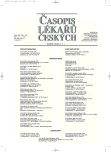Benefit of paracorporeal pulsatile assist device in multiorgan failing patients in terminal stage of heart failure
Authors:
Ivan Netuka 1,4; Jiří Malý 1,4; Hynek Říha 3; Ondrej Szárszoi 1,4; Zora Dorazilová 2; Ivo Skalsky 1; Daniel Turek 1; Marián Urban 1; Jiří Kettner 2; Jan Pirk 1,4
Authors‘ workplace:
Institut klinické a experimentální medicíny Praha, Klinika kardiovaskulární chirurgie
1; Institut klinické a experimentální medicíny Praha, Klinika kardiologie
2; Institut klinické a experimentální medicíny Praha, Klinika anesteziologie a resuscitace
3; Institut klinické a experimentální medicíny Praha, Centrum výzkumu chorob srdce a cév
4
Published in:
Čas. Lék. čes. 2011; 150: 44-48
Category:
Original Article
Overview
Background:
Prevalence of terminal forms of heart failure is steadily increasing and thus waiting time for heart transplantation, too. Increasing mortality on waiting list has urged implementation of mechanical circulatory support as an adjunct to the programme of heart transplantation. The objective of the study is to review 7-years experience with paracorporeal assist device in bridging to transplantation.
Material and methods:
Retrospective review of 53 transplant candidates treated since April 2003. 50 patients received paracorporeal assist devices in biventricular configuration. Most frequent diagnosis was dilated cardiomyopathy in 51%.
Results.
Despite a high risk profile of the patients, 37 of them were successfully transplanted (69.8%). Cumulative support has reached 3513 days. Local exit sites infection was identified as a most frequent complication, sepsis as a most frequent cause of death on support (18.8%). 30‑days post – transplant mortality remained low at 5.7%.
Conclusions:
Paracorporeal mechanical circulatory assist devices remain effective alternative for terminal stage heart transplant candidates, especially for those in multiorgan failure who require biventricular support. Success rate of bridging to transplantation is acceptable, as well as complications rate and quality of life while on support. Long-term post-transplant survival is not inferior to the results of procedures performed without necessity of previous implantation of the assist device.
Key words:
heart transplantation, ventricular assist device, biventricular configuration, paracorporeal, multiorgan failure.
Sources
1. Kettner J, et al. Mechanická podpora krevního oběhu – první zkušenosti v ČR. Čas Lék čes 2005; 144: 38–42.
2. Farrar DJ, et al. Preoperative and postoperative comparison of patients with univentricular and biventricular support with the thoratec ventricular assist device as a bridge to cardiac transplantation. J Thorac Cardiovasc Surg 1997; 113: 202–209.
3. McBride LA, et al. Clinical experience with 111 thoratec ventricular assist devices. Ann Thorac Surg 1999; 67: 1233–1238.
4. Haddad M, et al. Ventricular assist devices as a bridge to cardiac transplantation: the Ottawa experience. Artif Organs 2004; 28: 136–141.
5. El-Banayosy A, et al. Predictors of survival in patients bridged to transplantation with the thoratec VAD device: a single-center retrospective study on more than 100 patients. J Heart Lung Transplant 2000; 19: 964–948.
6. Magliato KE, et al. Biventricular support in patiens with profound cardiogenic shock: a single centre experience. ASAIO J 2003; 49: 475–479.
7. Kirsch M, et al. Single-centre experience with Thoratec paracorporeal assist device for patiens with primary cardiac failure. Arch Cardiovasc Dis 2009; 102: 509–518.
8. Rao V, et al. Revised screening scale to predict survival after insertion of a left ventricular assist device. J Thorac Cardiovasc Surg 2003; 125: 855–862.
9. Ochiai Y, et al. Predictors of severe right ventricular failure after implantable left ventricular assist device insertion: analysis of 245 patients. Circulation 2002; 106: I198–I202.
10. Kormos RL, et al. Transplant candidate‘s clinical status rather than right ventricular function defines need for univentricular versus biventricular support. J Thorac Cardiovasc Surg 1996; 111: 773–782.
11. Schenk S, et al. Duration of inotropic support after left ventricular assist device implantation: risk factors and impact on outcome. J Thorac Cardiovasc Surg 2006; 131: 447–454.
12. Fitzpatrick JR, et al. Early planned institution of biventricular mechanical circulatory support results in improved outcomes compared with delayed conversion of a left ventricular assist device to a biventricular assist device. J Thorac Cardiovasc Surg 2009; 137: 971–977.
13. Morgan JA, et al. Is severe right ventricular failure in left ventricular assist device recipients a risk factor for unsuccessful bridging to transplant and post-transplant mortality. Ann Thorac Surg 2004; 77: 859–863.
14. Holman WL, et al. Infection in ventricular assist devices: prevention and treatment. Ann Thorac Surg 2003; 75: S48–S57.
15. Goldstein DJ, et al. Left ventricular assist devices and bleeding: adding insult to injury. Ann Thorac Surg. 2003; 75: S42–S47.
16. Bába A, et al. Microcirculation of the bulbar conjunctiva in the goat implanted with a total artificial heart: effects of pulsatile and nonpulsatile flow. ASAIO J 2004; 50: 321–327.
17. Sezai A, et al. Major organ function under mechanical support: comparative studies of pulsatile and nonpulsatile circulation. Artif Organs 1999; 23: 280–285.
Labels
Addictology Allergology and clinical immunology Angiology Audiology Clinical biochemistry Dermatology & STDs Paediatric gastroenterology Paediatric surgery Paediatric cardiology Paediatric neurology Paediatric ENT Paediatric psychiatry Paediatric rheumatology Diabetology Pharmacy Vascular surgery Pain managementArticle was published in
Journal of Czech Physicians

Most read in this issue
- Acute liver failure: Present recommendations
- Hyperglycemia and its control in the critically ill patient
- Eversion carotid endarterectomy: evaluation of results after changing the operation technique
- Kidney transplantation at the Institute for Clinical and Experimental Medicine
